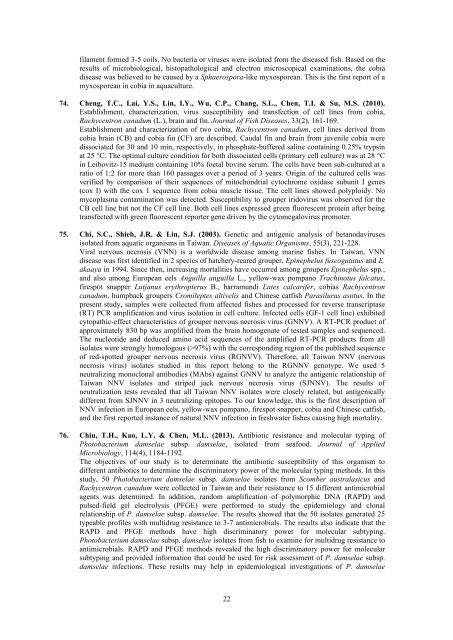COBIA (Rachycentron canadum)
4tEewMrkr
4tEewMrkr
- No tags were found...
You also want an ePaper? Increase the reach of your titles
YUMPU automatically turns print PDFs into web optimized ePapers that Google loves.
filament formed 3-5 coils. No bacteria or viruses were isolated from the diseased fish. Based on theresults of microbiological, histopathological and electron microscopical examinations, the cobiadisease was believed to be caused by a Sphaerospora-like myxosporean. This is the first report of amyxosporean in cobia in aquaculture.74. Cheng, T.C., Lai, Y.S., Lin, I.Y., Wu, C.P., Chang, S.L., Chen, T.I. & Su, M.S. (2010).Establishment, characterization, virus susceptibility and transfection of cell lines from cobia,<strong>Rachycentron</strong> <strong>canadum</strong> (L.), brain and fin. Journal of Fish Diseases, 33(2), 161-169.Establishment and characterization of two cobia, <strong>Rachycentron</strong> <strong>canadum</strong>, cell lines derived fromcobia brain (CB) and cobia fin (CF) are described. Caudal fin and brain from juvenile cobia weredissociated for 30 and 10 min, respectively, in phosphate-buffered saline containing 0.25% trypsinat 25 °C. The optimal culture condition for both dissociated cells (primary cell culture) was at 28 °Cin Leibovitz-15 medium containing 10% foetal bovine serum. The cells have been sub-cultured at aratio of 1:2 for more than 160 passages over a period of 3 years. Origin of the cultured cells wasverified by comparison of their sequences of mitochondrial cytochrome oxidase subunit I genes(cox I) with the cox 1 sequence from cobia muscle tissue. The cell lines showed polyploidy. Nomycoplasma contamination was detected. Susceptibility to grouper iridovirus was observed for theCB cell line but not the CF cell line. Both cell lines expressed green fluorescent protein after beingtransfected with green fluorescent reporter gene driven by the cytomegalovirus promoter.75. Chi, S.C., Shieh, J.R. & Lin, S.J. (2003). Genetic and antigenic analysis of betanodavirusesisolated from aquatic organisms in Taiwan. Diseases of Aquatic Organisms, 55(3), 221-228.Viral nervous necrosis (VNN) is a worldwide disease among marine fishes. In Taiwan, VNNdisease was first identified in 2 species of hatchery-reared grouper, Epinephelus fuscogutatus and E.akaaya in 1994. Since then, increasing mortalities have occurred among groupers Epinephelus spp.,and also among European eels Anguilla anguilla L., yellow-wax pompano Trachinotus falcatus,firespot snapper Lutjanus erythropterus B., barramundi Lates calcarifer, cobias <strong>Rachycentron</strong><strong>canadum</strong>, humpback groupers Cromileptes altivelis and Chinese catfish Parasilurus asotus. In thepresent study, samples were collected from affected fishes and processed for reverse transcriptase(RT) PCR amplification and virus isolation in cell culture. Infected cells (GF-1 cell line) exhibitedcytopathic-effect characteristics of grouper nervous necrosis virus (GNNV). A RT-PCR product ofapproximately 830 bp was amplified from the brain homogenate of tested samples and sequenced.The nucleotide and deduced amino acid sequences of the amplified RT-PCR products from allisolates were strongly homologous (>97%) with the corresponding region of the published sequenceof red-spotted grouper nervous necrosis virus (RGNVV). Therefore, all Taiwan NNV (nervousnecrosis virus) isolates studied in this report belong to the RGNNV genotype. We used 5neutralizing monoclonal antibodies (MAbs) against GNNV to analyze the antigenic relationship ofTaiwan NNV isolates and striped jack nervous necrosis virus (SJNNV). The results ofneutralization tests revealed that all Taiwan NNV isolates were closely related, but antigenicallydifferent from SJNNV in 3 neutralizing epitopes. To our knowledge, this is the first description ofNNV infection in European eels, yellow-wax pompano, firespot snapper, cobia and Chinese catfish,and the first reported instance of natural NNV infection in freshwater fishes causing high mortality.76. Chiu, T.H., Kao, L.Y. & Chen, M.L. (2013). Antibiotic resistance and molecular typing ofPhotobacterium damselae subsp. damselae, isolated from seafood. Journal of AppliedMicrobiology, 114(4), 1184-1192.The objectives of our study is to determinate the antibiotic susceptibility of this organism todifferent antibiotics to determine the discriminatory power of the molecular typing methods. In thisstudy, 50 Photobacterium damselae subsp. damselae isolates from Scomber australasicus and<strong>Rachycentron</strong> <strong>canadum</strong> were collected in Taiwan and their resistance to 15 different antimicrobialagents was determined. In addition, random amplification of polymorphic DNA (RAPD) andpulsed-field gel electrolysis (PFGE) were performed to study the epidemiology and clonalrelationship of P. damselae subsp. damselae. The results showed that the 50 isolates generated 25typeable profiles with multidrug resistance to 3-7 antimicrobials. The results also indicate that theRAPD and PFGE methods have high discriminatory power for molecular subtyping.Photobacterium damselae subsp. damselae isolates from fish to examine for multidrug resistance toantimicrobials. RAPD and PFGE methods revealed the high discriminatory power for molecularsubtyping and provided information that could be used for risk assessment of P. damselae subsp.damselae infections. These results may help in epidemiological investigations of P. damselae22


